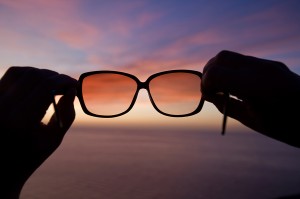Eye Health & Vision Care
 Eye Health and Healthy Eyesight Are A Way Of Life
Eye Health and Healthy Eyesight Are A Way Of Life
Many of the same healthy habits that protect your general health also promote healthy eye sight and help protect your eyes:
- Eating a balanced diet rich in fiber, fruits and vegetables
- Drinking water to hydrate your body and your eyes
- Not smoking, and avoiding long-term smoke exposure
- Wearing ultraviolet (UV) eye protection
- Considering appropriate vitamin supplements
- Antioxidants such as vitamins C and E and carotenoids such as Lutein and Zeaxanthin have shown some promise in research studies at reducing the risk and progression of cataracts and age-related macular degeneration (AMD) and other eye problems
- Regular medical and eyecare checkups
Healthy Sight And You
Research shows a surprising number of healthy sight habits go overlooked. Regular visits to your eye doctor. Fully treating diagnosed eye problems with proper medication when prescribed. Following instructions on medicine bottles and taking all medication until it’s gone. Talking with your eye doctor about other prescription medications that might interact with your eyecare medication. These are just a few of the basic eyecare practices that most of us don’t adhere to.
Do you work in low light or even poor lighting conditions when reading or working? Many of us do! Do you adjust your computer screen to fit your working environment? Many of us don’t! Yet proper light management is essential to proper eye health, healthy vision and comfort.
How active are you outdoors? Both glare and UV radiation present particular visual hazards and dangers. Take the time to understand how to minimize both, with protective lenses or lens products that have glare reduction and 100% UV blockage built-in.
Finally, how much are you willing to work at keeping your eyes as healthy as can be? Are you ready to commit to a lifetime of healthy sight? As you can see, there is much to think about.
Protecting Your Eyes From Injury And Other Hazards
The challenge of protecting your eyes can be fully met by a general awareness of how to protect your eyes as well as knowing which of today’s lenses and lens products are specifically designed for eye protection.

Protecting Your Eyes From The World Around You
Do you work in a hazardous environment like a construction zone or workshop? Do you participate in ball sports or extreme sports? Do you have active children who need everything from UV protection to protection from potential eye injuries? If your answer is “yes,” then sturdy, shatter-and-impact-resistant eyewear is a must. You have to protect your eyes, plain and simple.
Why you need eye protection:
- Nearly half of traumatic eye injuries relate to ball sports
- 45% of these occur in children under the age of 14
- 90% of these are preventable
- Polycarbonate is a lens material that is widely used for shatter-and-impact resistant lenses, and when combined with sturdy frame materials, work together to protect your eyes
- But protecting your eyes from physical hazards is only the beginning
Protecting Your Eyes From Dangers Seen and Unseen
Every day – sunny or cloudy, Spring through Winter – you are exposed to invisible ultraviolet rays as well as the visible dangers and potentially damaging effects of glare. Though a wide range of sunwear, lens treatments and photochromic technologies are available to help you protect your eyes, there’s no substitute for general knowledge and preparation for showing you why you need certain lenses and lens treatments to help protect your eyes.
UV Protection:
- UV light can “sunburn” the eye’s surface and cause benign yellowish growths on the human eye
- Prolonged exposure to harmful UVA and UVB radiation over time can contribute to serious, age-related eye conditions or diseases
- These diseases include cataracts and macular degeneration, the leading cause of blindness in people over age 60
- Only lens materials or lens treatments that promise 100% protection against both UVA and UVB rays protect your eyes fully from the harmful rays of the sun. Demand 100% UV protection.
Glare Protection:
- In daylight, glare can occur when walking indoors to outdoors, moving from shade to sunlight, even from reflected light off of surfaces like cars or sidewalks
- At night, glare can occur from oncoming headlights while driving, or from bright reflections off of wet roads, even signs
- Glare can impair visual comfort and visual quality, which can diminish healthy sight
- Anti-reflective (AR) treatments are available for many lens products to help protect your eyes. AR treatments are proven to significantly reduce glare while increasing visual comfort
- Various lens treatments and materials, along with leading lens technologies like photochromics, polarized lenses and new variable polarization can often be bundled into one lens offering for maximum versatility, as well as eye protection
Credit: www.eyeglassguide.com
